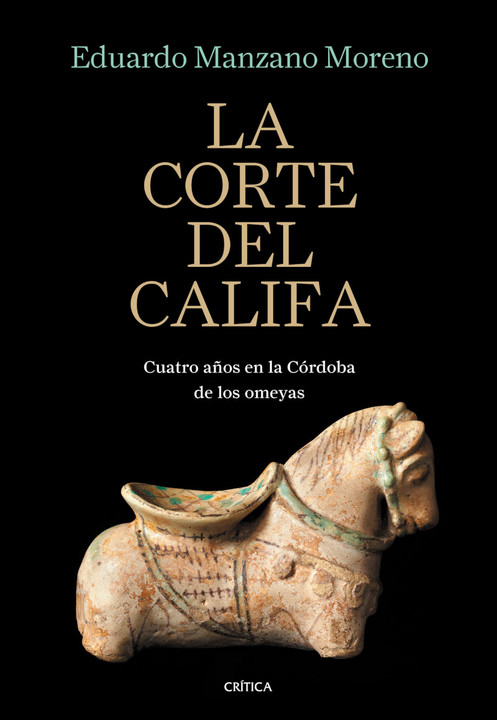

By 971 CE, the Umayyads, based in the city of Córdoba, had established themselves as major players in the geopolitics of their time. Ambassadors from rulers around the Mediterranean Basin, the Iberian Peninsula, and Western Europe frequented the halls of the caliphal city of Madīnat- al Zahrā as part of the complex diplomatic networks developing in the tenth century. Yet, less than forty years later, much of what these ambassadors described in their missals no longer existed, and the luxurious caliphal palace of Madīnat al-Zahrā was literally in the drains of one of the most advanced irrigation systems of its time. Histories composed in the eleventh century and those penned today evince both nostalgia for this lost so-called “golden age” as well as political musings surrounding whom to blame for its fall. Thankfully, Eduardo Manzano Moreno’s latest offering, La Corte del Califa: Cuatro años en la Córdoba de los omeyas (The Court of the Caliph: Four years in Umayyad Córdoba) published in January 2019, moves away from the fanciful and instead investigates a critical time in al-Andalus: the end of the reign of al-Ḥakam II from 971-975 CE, four years that witnessed both the apex of splendor of Córdoban al-Andalus as well as substantial changes in its governance.
Manzano Moreno’s examination of the final years of al-Ḥakam II’s reign offers us a much needed analysis of both what happened during this “golden age,” focusing not on the extreme wealth and strength of the Andalusi Umayyads at this time, but most importantly highlighting the ways in which administrative changes occurring in these years showed the fragile nature of their rule. Moreno aims to develop both an understanding of the intricacies of the apparatus of Umayyad rule as well as to appreciate how such a developed administration could fall apart so spectacularly.[1] One walks away from La Corte del Califa with a deep appreciation for the ability of the Umayyad rulers of al-Andalus to manage resources, develop networks, and negotiate governance in the Iberian Peninsula. While providing less definitive answers to his second question, Manzano Moreno’s narration of al-Ḥakam II’s subtle innovations in governance clearly point to the idea that the Umayyad’s desire to become major players in the Mediterranean world forced them to act in ways that ultimately destroyed their popular support, paving the way for popular revolution.
Based on ‘Īsa al-Rāzī’s (d. 989 CE; al-Rāzī’s father, Aḥmad al-Rāzī, had served as an official secretary, historian, and court poet for ‘Abd al-Rahmān III) contribution to Ibn Ḥayyān’s Muqtabis, Manzano Moreno’s account first renders the service of providing as complete a history of the text that he is analyzing as possible, an investigation that historians of al-Andalus have not always undertaken. Any scholar of tenth-century Arabic texts must engage in source criticism—in many ways this is the most exciting aspect of the field: tracing the intricacies of the development of the text. Accordingly, Manzano Moreno argues that though this particular source has had some currency in the past, those employing it often attribute it to Ibn Ḥayyān, an eleventh-century writer whose family had close ties to the Umayyad court. Ibn Ḥayyān’s works must be read through this lens: the fall of the Umayyads meant the fall of his family. However, Manzano Moreno accredits the Muqtabis to al-Rāzī, arguing that Ibn Ḥayyān’s work relies, as many Arabic histories do, on accounts from older generations. By attributing the Muqtabis to al-Rāzī, Manzano Moreno moves the authorship of this account from a disgruntled Umayyad partisan to an eye-witness’ telling by a secretary working in the court of al-Ḥakam II. Though the shift is subtle- after all, both al-Rāzī and Ibn Ḥayyān should be considered pro-Umayyad writers, al-Rāzī had no idea of the impending collapse of the Umayyad dynasty which uprooted and deeply shaped Ibn Ḥayyān’s worldview. Yet, La Corte del Califa provides an even more important service to historians interested in this source. What is not always examined is the ways that the selection and translation of Arabic texts into European languages has also affected its transmission and reception—and scholars outside of Spanish academia are indebted to Manzano Moreno for his elucidation of the politics of the Royal Academy of History in the 1960s and its effect on the transmission of this text.
La Corte del Califa refreshingly does not start with political or military history, but rather a chapter on the physical environment of the Iberian Peninsula in the ninth and tenth centuries. Foregrounding concerns with draught, flood, earthquakes, and the ways each of these affect crops and food supply, Manzano Moreno brings the reader back to the physical demands of governance. Those familiar with Andrew Watson’s or Thomas Glick’s work on agriculture and irrigation or D.F. Ruggles’ or Glaire Anderson’s work on gardens in al-Andalus[2] will find little new information on the subject in La Corte del Califa. Rather, Manzano Moreno’s use of the tenth-century Calendaria de Córdoba, an almanac-like source concerned with agriculture, meteorology, and physical health, is unique in the ways in which he combines it with al-Rāzī’s text to provide readers with the context for the achieved splendor of the Umayyad caliphate. Manzano Moreno demonstrates the complexity of managing the calendar—as taxation, and ultimately the accumulation of wealth—depended on vigilant management of seasonal production. Although Arabic histories often focus on military and monumental achievements or genealogy, leaving readers bereft of a sense of both place and a more general sense of how administrations functioned, Manzano Moreno’s careful curation of sources shows the ways that Umayyad administration developed a busy and extensive network capable of generating fantastic wealth by the middle of the tenth century.
Perhaps what is most stimulating in this analysis of the Muqtabis is rather than adhere to the chronology laid down by al-Rāzī, Manzano Moreno arranges La Corte del Califa thematically, allowing him to compare developments in al-Andalus from 971 to 975, but also those further afield in the Mediterranean and Western Europe occurring at the same time. La Corte del Califa thus proceeds by analyzing the ways in which the Umayyads channeled the capital that they accumulated through their detailed management of the Iberian Peninsula into many areas. Combining textual, visual, and archaeological sources, an integrated approach sadly still uncommon in many histories of al-Andalus, Manzano Moreno convincingly argues that expenditures of caliphal treasure amounted to some form of coercive power. Whether caliphs reinforced their governance through the distribution of wealth in the payment of salaries or gifts, the dispersal of alms, the establishment of endowments, the funding of military expeditions, the building of monumental architecture, or in ceremonial processions to celebrate holidays, military victories, or the arrival of ambassadors, each disbursement aimed at extending their influence and hegemony. In many aspects, such displays of power became necessary in the tenth century, as the Umayyads competed with the Fāṭimids and Idrisids of North Africa, the Būyids in Abbasid Baghdad and the Byzantines in the Eastern Mediterranean, and the Ottonians, Carolingians and Franks in Western Europe. Survival depended on increasing participation in the politics of power of the wider Mediterranean and European spheres. This need drove the establishment of caliphal workshops in the newly built Madīnat al-Zahrā, and Manzano Moreno is at his best when discussing the ways in which the creation of luxury items such as silks and ivories depended on the finely managed networks of taxation and gift-giving established by the Umayyads. To oversee this dizzying array of activities designed to attract and keep supporters, the caliphs, beginning with ‘Abd al Raḥmān III (r. 912-961), drastically increased the size of their administration.
Manzano Moreno wisely avoids teleological conclusions that might see the decisions of ‘Abd al-Raḥmān III or al-Ḥakam II to expand their retinue and empowering of different social groups as the cause of the popular revolution of 1009 that shook Córdoba. However, one can see that decisions that privileged enslaved persons or members of families from newly acquired North African territories, acted as departures from traditionally Umayyad ways of negotiating power. al-Ḥakam II relied increasingly less on the powerful kinship and client networks that had brought his ancestor, ‘Abd al-Raḥmān I to power in 756. Later, aspirants exploited these fissures to seize control for themselves, yet in doing so upset the delicate balance of power that had at least been nominally maintained as long as a member of the Umayyad dynasty sat on the throne.
La Corte del Califa thus provides a crucial look at the ways in which the propelling of the Umayyad caliphate onto an international stage prompted changes in its internal management. It is unreasonable to suggest that as the “second Umayyad caliphate” became a major international player that it should have maintained the same governing structures it had established at its onset. Yet, ironically, the very decisions that allowed the Umayyads to participate in this wider context of conspicuous consumption and display of power pulled at the social fabric of their dynasty. This situation is hardly new in world history, and Manzano Moreno’s articulation of this dynamic allows for and will hopefully encourage the inclusion of Umayyad al-Andalus in broader historical discussions. For far too long, histories of both Europe and the Middle East have marginalized the role of al-Andalus, privileging histories of the “Latin West” and the Eastern Mediterranean, respectively. Manzano Moreno thus argues for the re-inclusion of al-Andalus into these histories: conversations regarding the development of both Western Europe and the Middle East are notably weaker once one removes the Iberian Peninsula and North Africa from the picture. Thus, La Corte del Califa masterfully demonstrates how microhistories can illuminate broader conditions: after all, who would have thought that the analysis of four years in the Umayyad Córdoba under the rule of al-Ḥakam II could so persuasively argue for the need to reintegrate medieval Iberia into both Mediterranean and European history?
Sarah Slingluff is currently pursuing her Ph.D. in Art History at the University of Edinburgh. Her research focuses on material culture in the Southern Meseta in the eighth and ninth centuries and its representation in Spanish museums and sites of public memory.
La corte del califa: Cuatro años en la Córdoba de los omeyas
By Eduardo Manzano
Publisher: Editorial Crítica
Hardcover / 496 pages / 2019
ISBN: 978-8491990284
[1] “¿cómo pudo funcionar de una manera tan eficiente su maquinaria de poder? ¿y, en el segundo lugar, cómo fue posible que colapsara tan estrepitosamente poco tiempo después? (17).
[2] For further readings on this matter, look to Thomas Glick’s Irrigation and Society in Medieval Valencia (1970); “Hydraulic Technology in al-Andalus” The Legacy of Muslim Spain (1992); Julio Samsó’s “La tradición en los calendarios agrícolas hispanoárabes y norteafricanos” in Actas del II Congreso para el Estudio de la Cultura en el Mediterráneo Occidental (1975); D.F. Ruggles’ Gardens, Landscape, & Vision in the Palaces of Islamic Spain (2000) and Islamic Gardens and Landscapes (2008); and Glaire Anderson’s The Islamic Villa in Early Medieval Iberia (2013).
Published on July 20, 2020




